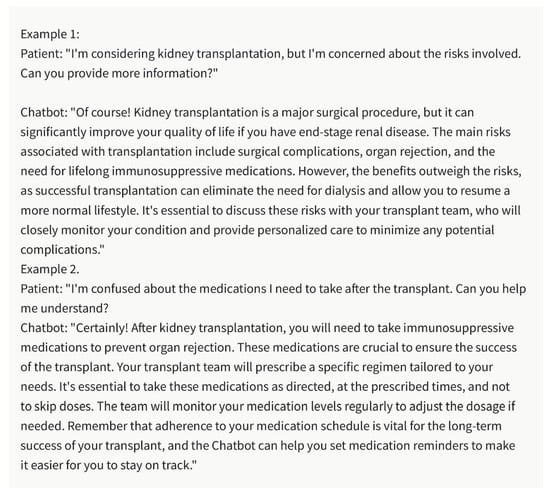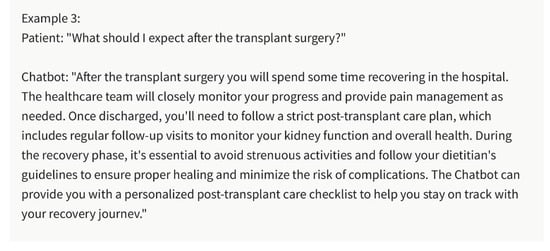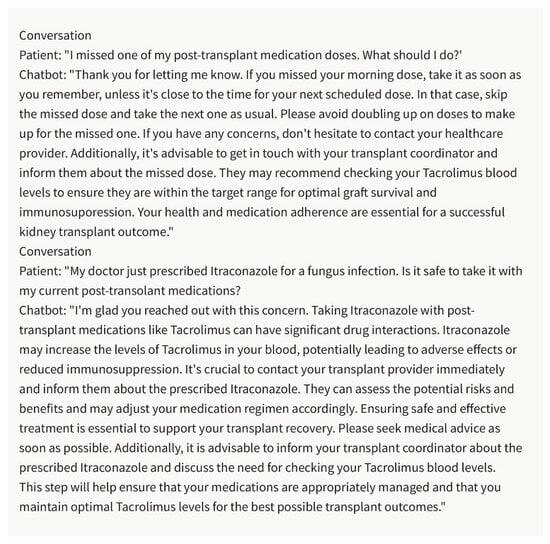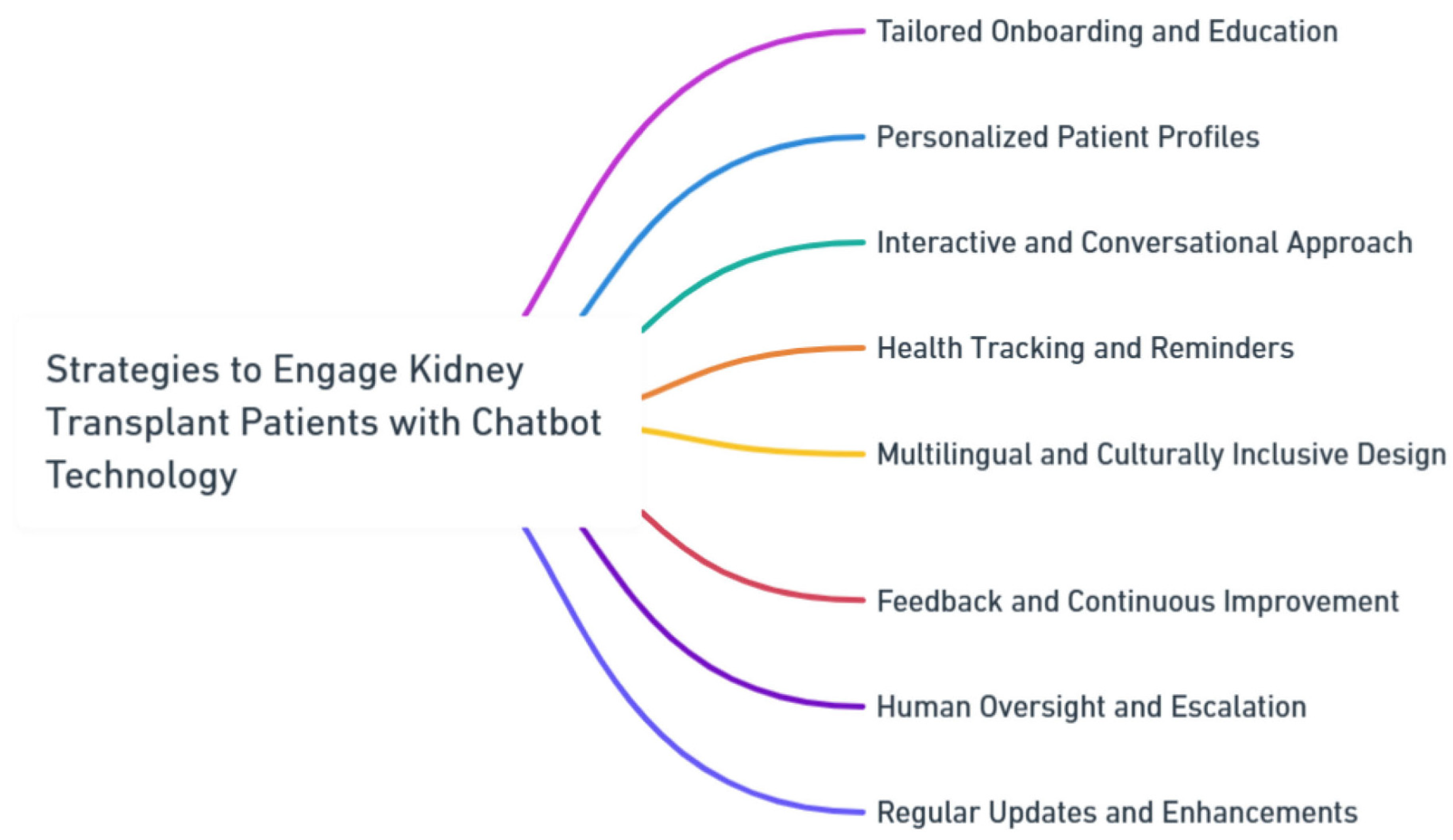Please note this is an old version of this entry, which may differ significantly from the current revision.
Kidney transplantation is a critical treatment option for end-stage kidney disease patients, offering improved quality of life and increased survival rates. However, the complexities of kidney transplant care necessitate continuous advancements in decision making, patient communication, and operational efficiency.
- kidney transplantation
- decision making
- operational efficiency
- AI
1. Overview of the Chatbot: Understanding the Artificial Intelligence Model
Chatbots and generative artificial intelligence (AI) have brought about advancements in the field of artificial intelligence and natural language processing. These interactive conversational agents are designed to mimic human interactions, while generative AI models can produce coherent content such as text, images, or audio [1][2][3]. These developments have revolutionized domains including healthcare, education, and customer service [2][3][4][5]. Chatbots operate using algorithms that process language, allowing them to understand user inputs and respond in a manner similar to human operators. These AI systems can follow predefined rules for their responses and generate outputs based on contextual understanding derived from their training data. Notably, models like GPT (generative pretrained transformer) have showcased language comprehension abilities by generating text that closely resembles human writing and engaging in nuanced interactions with users.
One particular example of the impact of OpenAI’s ChatGPT is its role in healthcare education where it provides search capabilities and helps address writing inaccuracies during manuscript creation. This valuable tool offers access to medical literature specifically related to kidney transplant care. Other noteworthy conversational agents powered by AI include BingChat developed by Microsoft and Bard AI developed by Google. These models also enhance search capabilities, correct writing errors, and facilitate literature evaluations. Bard AI has been extensively trained on text and code, enabling it to generate text that is contextually relevant, thereby offering versatile applications in healthcare such as aiding evidence-based decision making and improving communication (Table 1).
Table 1. Selected AI Chatbot Examples.
| Chatbot | Description |
|---|---|
| ChatGPT 3.5 | An advanced AI language model developed by OpenAI. It offers superior search functionalities, amends writing inaccuracies, and provides support in literature evaluations and manuscript creation. |
| ChatGPT 4.0 | An evolved version of ChatGPT with enhanced language comprehension, reasoning, and decision-making capabilities. |
| Bard AI | Developed by Google, Bard AI is trained on a vast dataset of text and code, including books, articles, and other forms of content. It can generate text, perform language translation tasks, create diverse creative content, and provide informative responses. |
| Bing Chat | BingChat constitutes an AI-powered dialogue system engineered by Microsoft, employing the capabilities of ChatGPT, an AI framework formulated by OpenAI. The foundational structure of ChatGPT is rooted in the design principles of the GPT model. |
| Claude AI | Conceived by Anthropic, stands as a manifestation of the organization’s dedicated endeavor to fabricate artificial intelligence frameworks distinguished by their practicality, ethical disposition, and steadfastness. Anchored within Claude AI resides a conversational agent, meticulously structured upon a natural language processing framework reminiscent of GPT-3. |
These AI-powered models offer healthcare professionals the ability to access up-to-date research, making literature evaluations easier and enhancing the creation of evidence-based manuscripts. Their potential is particularly valuable in the realm of kidney transplant care as they can assist with decision making, patient education, and communication, ultimately advancing patient care.
The evolution of chatbots has resulted in a version that boasts improved language processing, reasoning, and decision-making capabilities. Integrating this model into healthcare opens up possibilities by aiding in decision-making processes, providing timely information, and improving patient care. One practical application is decision support, which enables professionals to access medical information and guidelines for well-informed decision making. Additionally, patients benefit from information provided by the chatbot, empowering them on their journey towards better health. Nevertheless, responsible integration must address considerations and challenges such as accuracy, privacy protection, and transparency [3][6].
The enhanced capabilities of this chatbot make it an invaluable tool for healthcare professionals [7]. It assists in decision-making processes and interprets medical images accurately, contributing to diagnostic precision and thereby improving kidney transplant care [8][9][10][11][12][13][14][15].
Clinical Decision Support for Kidney Transplant Evaluation:
The evaluation of potential kidney transplant recipients involves comprehensive assessments to ensure appropriate patient selection and optimize transplant outcomes. The chatbot can serve as a valuable tool in this process, leveraging its natural language processing capabilities to analyze clinical data, patient histories, and risk factors. By providing real-time recommendations and evidence-based guidelines, the chatbot assists healthcare professionals in making informed decisions during the evaluation phase. This support can enhance the accuracy and efficiency of kidney transplant evaluations, leading to improved patient selection and better long-term transplant outcomes.
2. Pre-Transplant Patient Education and Communication
Effective patient education and communication are critical for successful kidney transplantation. The chatbot can contribute to this aspect of care by providing personalized and understandable information to potential transplant recipients (Figure 1). By analyzing patient queries, the chatbot can offer clear explanations about the transplantation process, potential risks and benefits, medication regimens, and post-transplant care requirements. This enables healthcare professionals to deliver tailored education to patients, address their concerns, and promote informed decision making. Enhanced patient education and communication facilitated by the chatbot can improve patient satisfaction, engagement, and adherence throughout the kidney transplant course.


Figure 1. Pre-Transplant Patient Education and Care with the Chatbot. Please note that the above sentences were generated by ChatGPT 3.5 for the purpose of demonstrating Pre-Transplant Patient Education and Care with the chatbot.
3. Post-Transplant Care and Medication Management
Post-transplant care and long-term medication management are crucial for ensuring graft survival and preventing complications in kidney transplant recipients. The chatbot can play a significant role in supporting healthcare professionals in this aspect of care (Figure 2). By analyzing patient-specific data, laboratory results, and clinical notes, the chatbot can offer real-time recommendations for medication dosages, monitoring schedules, and potential drug interactions [16][17][18][19]. This assistance helps healthcare professionals optimize medication management, ensuring appropriate immunosuppression and minimizing the risk of rejection or adverse events. By improving post-transplant care, the chatbot contributes to better patient outcomes and long-term graft survival.

Figure 2. Post-Transplant Care and Medication Management. Please note that the above sentences were generated by ChatGPT 3.5 for the purpose of demonstrating Post-Transplant Care and Medication Management Care with the chatbot.
4. Training and Education of Healthcare Professionals
To effectively utilize the chatbot in kidney transplant care, healthcare professionals need adequate training and education on its usage and limitations. Educational programs and workshops should be developed to enhance the digital literacy of healthcare professionals and familiarize them with the functionalities and potential applications of the chatbot. By promoting knowledge and skill development, training initiatives enable healthcare professionals to leverage the chatbot effectively, integrate it into their practice, and optimize its benefits for kidney transplant recipients.
4.1. Strategies to Engage Kidney Transplant Patients with Chatbot Technology
To enhance patient engagement with chatbot technology in kidney transplant care, several strategies can be employed (Figure 3):

Figure 3. Strategies to Engage Kidney Transplant Patients with Chatbot Technology. The diagram provided was generated using Whimsical, a tool known for its meticulous design and high-quality visual representations.
A well-structured onboarding process is recommended to introduce patients to the capabilities and limitations of the chatbot. This could encompass educational materials and interactive sessions explaining how the chatbot supports various aspects of the transplant journey. By addressing potential concerns and clarifying the chatbot’s role, patient trust and confidence can be built.
Creating personalized patient profiles within the chatbot enables tailored interactions. Patients can provide medical history, preferences, and communication styles, which the chatbot can use to offer guidance aligned with their unique needs. Adopting a conversational and interactive interface design enhances engagement. Leveraging natural language processing and employing empathetic language fosters a more human-like interaction, making patients feel understood and valued.
Integrating health tracking features, such as medication reminders and appointment scheduling, directly within the chatbot interface empowers patients to adhere to their medical regimen. This approach fosters proactive involvement in their care. Recognizing the diversity of kidney transplant patients, a multilingual and culturally inclusive chatbot design is crucial. By accommodating various languages, cultural norms, and communication styles, patients from different backgrounds can effectively engage.
Encouraging patient feedback and integrating insights into chatbot development refine the technology effectively. Mechanisms for human oversight and escalation ensure patients have access to healthcare professionals when needed. Demonstrating a commitment to continuous improvement by updating the chatbot’s capabilities based on patient feedback fosters engagement and responsiveness to evolving needs. These strategies collectively enhance the patient experience and outcomes in kidney transplant care through chatbot technology.
4.2. The Limitations of Chatbots in Kidney Transplant Care
Although the integration of chatbots in kidney transplant care holds promise, it is crucial to acknowledge and address the limitations associated with this technology. One significant concern is the risk of patients relying solely on chatbot advice, which could lead to a delay in seeking urgent medical attention. While chatbots can provide information and recommendations, they cannot replace the expertise and immediate assessment provided by healthcare professionals. There is a possibility that patients may misinterpret or underestimate their symptoms based on interactions with chatbots, resulting in delayed visits to the kidney transplant unit. In the context of transplant care, timely intervention is vital, and depending on chatbots without medical experts’ oversight could hinder prompt medical attention required during critical situations. Moreover, chatbots are limited by their inability to provide personalized care that takes into account the unique medical history, complexities, and specific needs of individual patients. While they can offer general information, they may not accurately capture the intricate details of a patient’s condition. This lack of personalization could lead to suboptimal recommendations or advice that does not align with a patient’s specific medical circumstances. In renal transplantation management, individualized medical directives are essential to guarantee the best possible results for each unique patient trajectory. In addition, chatbots have limitations when it comes to relying on available data. The accuracy of the recommendations provided by chatbots depends heavily on the quality and accuracy of the input data. If patients or external sources provide outdated information, there is a possibility of receiving inaccurate advice from the chatbot. Moreover, while chatbots can handle a range of scenarios, they might struggle with complex or uncommon cases that do not fit into standard patterns. In such situations, healthcare professionals who possess specialized expertise are better suited to make well-informed decisions (Figure 4). While chatbots have the potential to enhance kidney transplant care, their limitations may become even more pronounced in areas with limited technological resources or in culturally diverse settings. Understanding these limitations and using chatbots as a supplementary tool rather than a replacement for medical expertise is crucial to ensuring that patients receive appropriate and timely care.

Figure 4. Limitations of Chatbots in Kidney Transplant Care.
4.3. Challenges in Integrating Chatbots with Existing Electronic Health Record (EHR) Systems
Integrating chatbots into kidney transplant care comes with its set of challenges that need careful consideration—especially regarding data security and confidentiality (Figure 5). The integration needs to follow data security standards and patient confidentiality regulations like HIPAA compliance to protect sensitive patient information and build trust. Additionally, integrating chatbots with EHR systems presents a significant challenge. Various healthcare institutions may use EHR systems with unique data formats and structures. To achieve interoperability, careful consideration is required for mapping and converting data. It is also crucial to ensure data input for successful chatbot interactions. The integration should address challenges related to data quality and accuracy by updating lab results and medication changes to avoid providing potentially misleading recommendations. Effective integration with multidisciplinary care teams is essential as well. Given the nature of kidney transplant care involving diverse healthcare professionals, chatbots need to seamlessly fit into existing workflows and communication channels within these teams. Finally, cultural and language considerations are factors, especially in culturally diverse settings. Integration strategies should accommodate variations in communication styles and language preferences so that chatbots can navigate nuances and cultural sensitivities when interacting with patients and caregivers.

Figure 5. Challenges in Integrating Chatbots with EHR Systems.
Considering these limitations, it is crucial to emphasize that chatbots should be seen as a complement to medical expertise rather than a replacement for it. The medical field already has regulations in place to ensure patient safety and quality care. To mitigate any risks associated with reliance on chatbots, standardized guidelines should be established to guide patients on when it is appropriate to seek human medical consultation instead of relying solely on chatbot advice. By adhering to these guidelines and utilizing chatbots as tools that enhance the knowledge and skills of healthcare professionals, integrating AI technologies can have an impact on kidney transplant care outcomes while maintaining the highest standards of medical practice.
By conducting these future studies, the field of kidney transplant care can further refine and optimize the integration of AI technology like chatbots. These studies can have significant implications for improving patient outcomes, enhancing clinical decision making, promoting patient engagement, and ensuring the ethical and equitable use of AI in kidney transplantation.
4.4. Envisioning the Future of Chatbot Technology in Healthcare
As researchers peer into the horizon of healthcare, researchers envisage a dynamic realm wherein AI-powered chatbots assume a progressively influential role in reshaping the dynamics between patients and healthcare providers, thereby enhancing overall healthcare outcomes. Researchers anticipate an evolution of chatbots into sophisticated virtual companions seamlessly integrated into patients’ healthcare journeys. This evolution holds the promise of offering personalized health monitoring, timely interventions, and proactive health management. The adaptive nature of chatbots could equip them with the capability to discern subtle shifts in patients’ conditions, issuing early alerts for potential health concerns. Moreover, their proficiency in delivering accurate medical information and advice on-demand stands to empower patients to make well-informed decisions about their health.
4.5. Expanding Integration to Other Areas of Medicine
The success story of chatbot integration within kidney transplant care serves as a blueprint for its broader application across diverse medical domains. Chronic disease management emerges as a particularly fertile ground. Conditions such as diabetes, cardiovascular diseases, and respiratory disorders demand continuous vigilance and patient education. Here, chatbots could offer tailored guidance encompassing medication adherence, lifestyle adjustments, and symptom management, thus aiding patients in effectively managing their conditions. Furthermore, the potential of chatbots extends to mental health support. By providing a confidential and non-judgmental platform, they could offer a means for individuals to express emotions, propose coping strategies, and even recommend professional assistance as needed. Moreover, primary care settings stand to gain from chatbot technology, alleviating healthcare providers from routine tasks like appointment scheduling, prescription refills, and general health inquiries. Notably, chatbots could revolutionize patient education by delivering easily digestible medical information, thereby enhancing health literacy across diverse demographics. In the domain of telemedicine, chatbots could efficiently triage patient inquiries, effectively directing them to suitable resources or medical experts.
In summary, the integration of a chatbot, an advanced AI language model, holds significant potential for enhancing kidney transplant care and improving patient outcomes. Chatbots can provide valuable support in various aspects of kidney transplant practice, including clinical decision making, patient education and communication, post-transplant care, data analysis and research, and addressing disparities. By assisting healthcare professionals in making informed decisions, delivering personalized education, optimizing medication management, supporting communication, and aiding in data analysis, chatbots contribute to improved patient selection, engagement, adherence, and long-term transplant success. However, ethical considerations, bias mitigation, interpretability, training, and standardization are crucial factors for ensuring the responsible and effective integration of chatbots in kidney transplant care.
This entry is adapted from the peer-reviewed paper 10.3390/healthcare11182518
References
- Jie, Z.; Zhiying, Z.; Li, L. A meta-analysis of Watson for Oncology in clinical application. Sci. Rep. 2021, 11, 5792.
- Harrer, S. Attention is not all you need: The complicated case of ethically using large language models in healthcare and medicine. EBioMedicine 2023, 90, 104512.
- Lee, P.; Bubeck, S.; Petro, J. Benefits, Limits, and Risks of GPT-4 as an AI Chatbot for Medicine. N. Engl. J. Med. 2023, 388, 1233–1239.
- Miao, J.; Thongprayoon, C.; Cheungpasitporn, W. Assessing the Accuracy of ChatGPT on Core Questions in Glomerular Disease. Kidney Int. Rep. 2023, 8, 1657–1659.
- Suppadungsuk, S.; Thongprayoon, C.; Krisanapan, P.; Tangpanithandee, S.; Garcia Valencia, O.; Miao, J.; Mekraksakit, P.; Kashani, K.; Cheungpasitporn, W. Examining the Validity of ChatGPT in Identifying Relevant Nephrology Literature: Findings and Implications. J. Clin. Med. 2023, 12, 5550.
- Beaulieu-Jones, B.K.; Yuan, W.; Brat, G.A.; Beam, A.L.; Weber, G.; Ruffin, M.; Kohane, I.S. Machine learning for patient risk stratification: Standing on, or looking over, the shoulders of clinicians? NPJ Digit. Med. 2021, 4, 62.
- Knight, W. The dark secret at the heart of AI. MIT Technol. Rev. 2017, 120, 54–65.
- Wang, X.; Peng, Y.; Lu, L.; Lu, Z.; Bagheri, M.; Summers, R.M. Chestx-ray8: Hospital-scale chest X-ray database and benchmarks on weakly-supervised classification and localization of common thorax diseases. In Proceedings of the IEEE Conference on Computer Vision and Pattern Recognition, Honolulu, HI, USA, 21–26 July 2017; pp. 2097–2106.
- Li, Z.; Wang, C.; Han, M.; Xue, Y.; Wei, W.; Li, L.-J.; Li, F.-F. Thoracic disease identification and localization with limited supervision. In Proceedings of the IEEE Conference on Computer Vision and Pattern Recognition, Salt Lake City, UT, USA, 18–23 June 2018; pp. 8290–8299.
- Ker, J.; Wang, L.; Rao, J.; Lim, T. Deep learning applications in medical image analysis. IEEE Access 2017, 6, 9375–9389.
- Nam, J.G.; Park, S.; Hwang, E.J.; Lee, J.H.; Jin, K.-N.; Lim, K.Y.; Vu, T.H.; Sohn, J.H.; Hwang, S.; Goo, J.M. Development and validation of deep learning–based automatic detection algorithm for malignant pulmonary nodules on chest radiographs. Radiology 2019, 290, 218–228.
- Yu, K.-H.; Zhang, C.; Berry, G.J.; Altman, R.B.; Ré, C.; Rubin, D.L.; Snyder, M. Predicting non-small cell lung cancer prognosis by fully automated microscopic pathology image features. Nat. Commun. 2016, 7, 12474.
- Ehteshami Bejnordi, B.; Veta, M.; van Diest, P.; Ginneken, B.; van Karssemeijer, N.; Litjens, G.; van der Laak, J.A.W.M. Diagnostic assessment of deep learning algorithms for detection of lymph node metastases in women with breast cancer. JAMA 2017, 318, 2199–2210.
- Christiansen, E.M.; Yang, S.J.; Ando, D.M.; Javaherian, A.; Skibinski, G.; Lipnick, S.; Mount, E.; O’neil, A.; Shah, K.; Lee, A.K. In silico labeling: Predicting fluorescent labels in unlabeled images. Cell 2018, 173, 792–803.e719.
- Weigert, M.; Schmidt, U.; Boothe, T.; Müller, A.; Dibrov, A.; Jain, A.; Wilhelm, B.; Schmidt, D.; Broaddus, C.; Culley, S. Content-aware image restoration: Pushing the limits of fluorescence microscopy. Nat. Methods 2018, 15, 1090–1097.
- Tatonetti, N.P.; Ye, P.P.; Daneshjou, R.; Altman, R.B. Data-driven prediction of drug effects and interactions. Sci. Transl. Med. 2012, 4, 125ra131.
- Beam, A.L.; Kohane, I.S. Translating Artificial Intelligence Into Clinical Care. JAMA 2016, 316, 2368–2369.
- Zarrinpar, A.; Lee, D.-K.; Silva, A.; Datta, N.; Kee, T.; Eriksen, C.; Weigle, K.; Agopian, V.; Kaldas, F.; Farmer, D. Individualizing liver transplant immunosuppression using a phenotypic personalized medicine platform. Sci. Transl. Med. 2016, 8, 333ra349.
- Luechtefeld, T.; Marsh, D.; Rowlands, C.; Hartung, T. Machine Learning of Toxicological Big Data Enables Read-Across Structure Activity Relationships (RASAR) Outperforming Animal Test Reproducibility. Toxicol. Sci. 2018, 165, 198–212.
This entry is offline, you can click here to edit this entry!
 Encyclopedia
Encyclopedia
